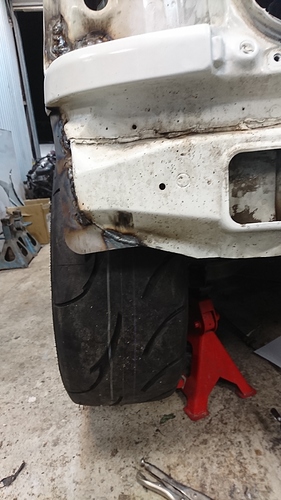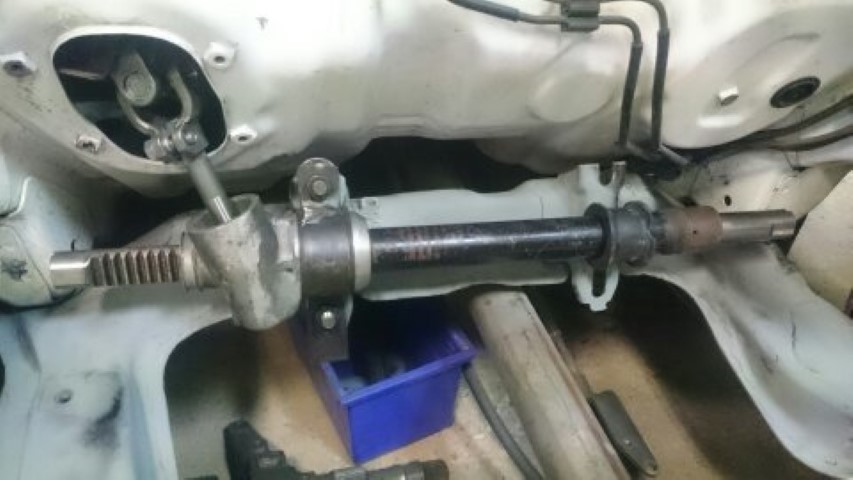Taking a break from this for a few days. Next up though “Suspension (and steering) take two - the right tires are key”.
Whats happening here!? cutting the wheel arch bigger and welding tubs?. What size tyres are they?
They have aggressive looking tread. What tyres are they?
Before going on it is suggested that you go back to the post of March 26th 2017 to read “And onto the suspension – take one”.
Something had to be done about getting better tires onto the car. The 175/50/13 Nangkang AS-1 were “so-so”. Looking into race radials few suppliers had anything in stock and some brands of tires had their best race rubber lists as 13”s but other than the Yokohama A048 in one compound only there was not supply [Did see today that Nangkang NS2R 180tw are now available and are a great value road tire that Gormsby currently has on the daily, but the N’G AR-1 would be closer to the right tire but the only thing in 13” is a 185/60] . There was the possibility of going with slicks (puts the thing into Sports Sedan for most events) but some 6” or wider rims would be needed. Some 6.5” and 7” thirteen inch wide rims in 114pcd were looked at and redrilling them or changing the pcd was considered. 14” were tried for a while. Road and road race tire options made it a bad move and only one set of fair imported tires were tried. A source of soft slicks in 14” were available but 7”- 8” wide rims would be needed. This was getting too hard. What to do? Try 15”s, just as can be seen in the very first image of this thread. At least a 195/50/15 in a road race radial is common place and there is lots of variety to try (thanks in no small part to the MX5 community). Well the big rims and tires bumped and rubbed “everywhere”. Struts would need small diameter coil over type springs fitted. Rear tubs would be needed and the trailing arms were really close to the tires. Wheel arches would need to come out front and rear even despite having been pulled out 10mm (something done when going from std 12” to 175s on 13”). And the front inner guard in front of the strut towers would also need moving up. It would need to come off the road for a bit and it would be eight months between drives. Some exploratory cutting of the rear guards began and at that point it was decided to fix the orientation of the rear callipers. In doing this the trailing arms had some of the spot weld pinch seems trimmed and the periphery was tig welded. The shock location was cut off and moved aft and up – but more on that latter. Some double adjustable Koni strut inserts were acquired from a friend’s parts bin, the other bits needed were collected for a custom coil over strut leg. A proper radius rod was looked at but rejected for reasons already previously mentioned. Instead the front K frame was altered to add two more sway bar bushes inboard of the factory ones to stop bar flex under braking and acceleration (considered a temp fix). Some trimming, gusset addition and tig welding of the seams was also done to it as well as raising the suspension pick up points by 20mm (old ones ground off and new ones added after carefully removing from a donor frame). The LHS pivot captive bolt was replaced with by broaching a hole into the frame and welding in a tube so the nut could be replaced. Holes were drilled above the sway bar captive nuts so these locations could be reinforced then closed back up. That left one big mod to do to the K frame.
In an earlier section it was explained that Gormsby had driven two remarkable full on race cars, the Formula Ford and than a Radical SR3. To make this thread interactive a question is poised to you. What does Gormsby see as the greatest barrier to moving the L200 project forward? Until a reader answers this correctly there will be no more posts. Here’s a hint, the answer has something to do with a quality inherent in those two race cars, the both had really fast…? Once someone figures it out that very thing , then the “handling” topic will resume.
I will take a stab in the dark here (a guess if you will) as I have heard you say about it many itmes in the past the mira has a terrible lock to lock count with steering. So to reduce this would vastly increase a more direct steering and give yourself quicker turning times and be able to handle the car better that what a current mira set up is and the formula ford and radical would both have a quicker turn on the steering wheel than a standard mira.
Would I be in the ball park somewhere there or do i need to go re-read again?
Spot on Evilhighway, well done. The 3.9 turns lock to lock was awful. The thread is unlocked and will continue.
Woohoo. 
No long winded explanation here. The search for quick racks meant looking at adding firstly a BMC mini rack (they are quick std-but no chance of fitting easily) and next searching for a TRXX rack which were rumored to be “quick”. No luck there. “Quick steering” would have to come from one of the racks that could receive the internals from this place
A used manual XXXX rack was purchased and sized up for fit. Engine was pulled out. The measurements and physical comparison looked good (original rack is shown next to the XXXX, can you tell which is which?)
Quaife internals were ordered for an option with a longer pinion spline so that the steering wheel could be moved rearward.
Last image shows a series of spacers added to lower the steering column. Shown is a test fit.
Brackets on the K frame would need to be moved inwards so they were removed. Before putting them back on the rack mounting holes were elongated so bump steer could latter be corrected.The old bracket was removed/cut from the column, a new 1.2mm sheet metal piece made up and welded back on. This was because the assembly was moved rearward.
Uploading…
While all was out the clutch pedal was braced also, and the brake pedal (the part one puts the rubber of one’s shoes base on onto haul the car up was widened so it can be found more easily, and it had some 36 grit sand paper glued to it [replaced as needed]).Clutch action is light (Thank you Jim Berry of Race Clutches) but since Gormsby has seen quite a few pedals break in his time he tigged some bits of 6mm rod in. Put them to one side of the clutch cable nut on the upper most part if you want to be able to get a spanner on to adjust at any time.
Here we digress for a moment. With the mention of clutches it should be pointed out that the reduced pressure plate height that can be the result of more clamping force (achieved simply a pivot point change that gives more clamp force {I shudder [pun intended] when I hear of the Franken clutches where more presure plate force is achieved by adding extra diaphram springs - the clutch pedal ends up so heavy that the pedals, pivots, cable and all need reinforcing. An when one problem has a solution that leads to another problem that needs a solution that leads to … you know it’s all wrong). So the pic shows that the tabs have been bent up and refolded down. This was to allow the fitting of a 3mm delrin spacer between the metal bearing and the original black plastic. Next option for more height if this has not been enough is to double up that top pressed cap by tack welding two together (maybe I’ll find a pic of that - the only one around here that way is fittted in the car).
Next we see the universals that allow the misalignment of the rack with the column. As the top brackets were moved so new ones were made for the bottom. The whole column was difficult to set up and tack weld in place. Much time was spent getting an almost NASCAR close to the wheel position and getting the steering wheel down low (top of the wheel should be about level with the base of one’s skull - as a rule of thumb). Note the lower universal is a hybrid of the one that came with the new rack and the L200 item. Lower half is black and covered with white overspray and upper half is bare metal. This required pulling the two original items apart and making one out of the two so that the output splines matched their associated shafts.
Not seen here but a pedal box for parallel brake master cylinders with an adjustable balance bar and dash mount knob was made up (okay the knob, adjust cable and heim joint were bought as a set). For now the brake pedal had its original “stomping spot” removed and a larger plate welded on then some 36grit sand paper added to ensure anyone driving would not have their foot slip off. Pressure to have the car ready for a motokhana precluded its fitment - for now. But when the 290mm discs go on the front that might be “the time”.
I have enjoyed your posts, there is great detail here and free sharing of hard gathered knowledge.
I recently found myself in a performance car parts shop buying a clutch. On display was countless examples of aftermarket parts for varous Hondas. I had one of those moments where I wondered why I bothered with modifying a Daihatsu, when it would be so much easier if I had a Civic or an Integra.
I wondered if Mr Gormsby has ever had those types of thoughts. What keeps him motivated with the work on the L200?
JC050 the whole process is a challenge. It brings deep understanding and there is a level of intrinsic satisfaction in making your own parts. At one stage a Honda or such was considered, however, Gormsby would still probably end up making many of his own bits. He’s okay sharing most of the knowledge. The rack make and model was an exception. This is since it required complex machining to fit and would be beyond most people’s ability. It is a prototype and some risk comes with that as well as concern about extreme tire rub a full lock which can result in a locked tire. Perhaps when it is all proven the info will come but for now some things will not be revealed in case someone mistakenly has a go and something goes wrong. Suffice to say anyone out there with the ability to pull off such a rack conversion will figure things out from the given info anyway. Those Honda people who are just bolting stuff on are playing “mechanic” when we have to problem solve with substitution or making bits we are playing “engineer”. There is the challenge to build which is enjoyable and better yet is driving something you’ve built and it being only a Daihatsu whipping the but of mega dollar builds is quite a buzz. The pinnacle though is driving a razor sharp car that you know really well on the limit.
Having some time off car work right now to work on a postgrad uni assignment (government policy - yawn). Did end up needing a break yesterday so stood at the lathe for three hours to make/finish some threaded M48 x 1 adjusters and make some big nuts. Will put some slots on the outer surface of the nuts so they can be tightened with a C spanner. These aren’t the final product but a prototype for running 1 7/8" diameter springs.
What rack is that that you have pictured?
Not sure if you are just curious, want to fit one to your own car, whether you think you can sell them or if you are kidding by asking? A lot of information has been given up on all elements of the build shown herein. You can rant and rave and say Gormsby is not being fair by not being straight up with what this part is. Go ahead and call him every name under the sun. Paint him with the same brush as you’ve done EFIMira. It has already been explained why further details of this item were not furnished.
If you are curious, then one in the picture is L200 and the other is not. To do this on your own car, there is enough information given that you could play Sherlock Holmes and figure it out. If you wanted to add this conversion to your line of items for sale in your online shop, then Gormsby suggests that the whole process would be out of the price range of all of your customers (unless they start asking if you sell Penske shocks). A used rack, new rack ends, tie rod ends and the Quaife internals were not much more than $1000au. Add two hours altering it on the lathe so $220. Universal change over perhaps another $110. K frame mod is a full day’s work. Custom passenger side rack bush $200. Driver’s side rack bush was really simple looking but tricky to make in Delrin as it is really thin - $100. The Quaife rack and pinion fitment into the donor L200 rack would be $200 plus. Add the time to figure it out. And if you were just kidding, Gormsby does not need it, he could use the time spent here documenting the build actually doing the build.
There are a few Daihatsu people out there who Gormby trusts. If they needed to know he would tell them for free. Just message and ask. If you are one to spruik your wares on the internet - don’t bother asking.
At this point in the build the focus was suppose to be on fitting big tires. But it was considered pointless chasing the improved handling they would bring without quick steering. With this solved and subsequently a better driving position the gearstick was a really big reach. The old gearstick had already been substantially lengthened so that one’s hand did not have to travel far from the steering wheel. Pivot points had been changed and despite being a long stick shift distances were ultra close. A new one was to come. With thoughts shifted to the transmission tunnel a plan was hatched to move the gearshifter base higher and about 200mm rearward, to go to a single brake line to the rear, add an adjustable bias valve within reach while seated and to add a hydraulic hand brake for motokhana and khanacross.
Look for the red thing in the lower right corner. This is the adjustable bias. The ultra long thing with gearknob atop is the hydro handbrake lever which is adjustable for position, reach and ratio. It may not stay like this as the transmission tunnel flexes a heap with its application. Gearstick uses an old rack end as its main pivot. The only original parts are the gearknob and sideways motion rocker (which has altered ratio). Gearstick is adjustable for length, position and shift speed. Original cables are lengthened by welding longer thread to the ends, note that they are connected to LH and RH heim joints that have a long barrel adjuster. All custom parts made using home lathe and mill. Shifter and bias adjuster works a treat.
Nothing else to say on this other than Gormsby thinks it looks to “techy” and it makes the car look suspiciously as though it could be “fast”. Sighh, the sleeper/stealth aspect is disappearing.
I think Mr Gormsby is right and ( in the 2nd post above your one) stated he is okay with sharing most information but the rack make and model is an exception.
I think that is fair as it his project and is sharing so much more than most of us even know or have done.
So let us be grateful with what Mr Gormsby has shown and shared with us.
Any reason why you didn’t want to just change the ratio of the steering in line of the steering column?
I spotted something on the Quaife website but it did say it was for power steering.
That last post I will admit that I looked at the picture before reading the text, then the second gear stick made more sense. Bloody good idea with moving the shifter to a rearward position, the L200 feels quite unrefined from standard. The position of my seat in the L60 makes the wheel about the same height at you said was ideal and the shifter in mine is well within reach.
Not a fan of steering quickners. They are popular in speedway. Have helped a friend install one like this
http://www.ianboettcherraceparts.com.au/shop/Steering-Quickner-2-1.html
into a hill climb car that has recirculating ball steering (it already had short steering arms but still not fast enough).
Doing such in the L200 would not have increased the steering angle. Not only does it now have two turns lock to lock but also more angle. Soon more room will be made for big tires in the front. At the moment the tires hit the front of the inner guard and rub lots. Will learn soon if “stops” have to be added to limit lock angle. Also the quickener takes up a bit of room and if the steering proves to heavy an electric power assist will need to be added. There is only room for elec assist or quickener along the length of the column.
Although not all the parts were weighed the major parts were and it carries less mass now. Quickener might have added a couple of kilograms once all mounted.
Juat say if you need more info on the shiftier. Extra pictures and info can be provided if there is interest. Oh, originally had made delrin bushes for the gearbox end of the shifter cables. These have now been swapped over to ball bearings. All feels hugely “mechanical” and precise now (well almost - the selectors inside the box could do with some attention to detail).
As regards to EFImira, I’m working off what I have heard from others and have no personal interactions with him.
I love your work and am amazed at how much time you must have put into the little L200. I was merely asking as it may spark my ideas on my own personal car. The way I see it is that if so much time and money was required to make it fit an l200, wouldn’t it be good to state the model so other people try something else instead?
With my background in motorsport, I can definitely see why you chose that option over a steering rack quickner, I’ve found that they make the steering unnecessarily hard. Just like you, I’m on this forum for the same reasons as anyone else, anyone can inbox me for information and I’m happy to give away everything I know. I prefer to make questions in posts though, so all the information is searchable for anyone new to the forum.
“no personal interaction with him” = rumors
The logic of “state the model so other people try something else” is flawed. A capable person should be able to figure out the part used based on the evidence given. Knowledge does not beget understanding and knowing exactly what bits to buy is recipe for disaster if one does not understand the problems they have just bought into. There was an explicit statement made to say that at this point in time further details would be withheld until testing was over, when beyond “prototype” done and if the mod was known to be safe info might be released.
To “make questions in posts” when answers have already been given shows arrogance or a lack of reading skills. It’s a bit like someone new popping up and asking “how do you fit an ej-de into an L200” when the topic is already documented. A questions should be specific, for example “when fitting an ej-de into an L200 does one use the original engine mounts?” or “how far back in an L200 engine bay can an Ej-de be placed without altering the firewall”.
Moving on the issue is done, dusted and forgotten.
As a teacher Gormsby gets to do some “educational” projects that are work related. Here’s attempt number two at making some ram pipes for the ej-de. It was done with some scraps of pre-preg carbon fibre. There was only just enough off-cuts from a friend’s bigger project. Compared to working with cloth and adding resin it was a delight to work with.
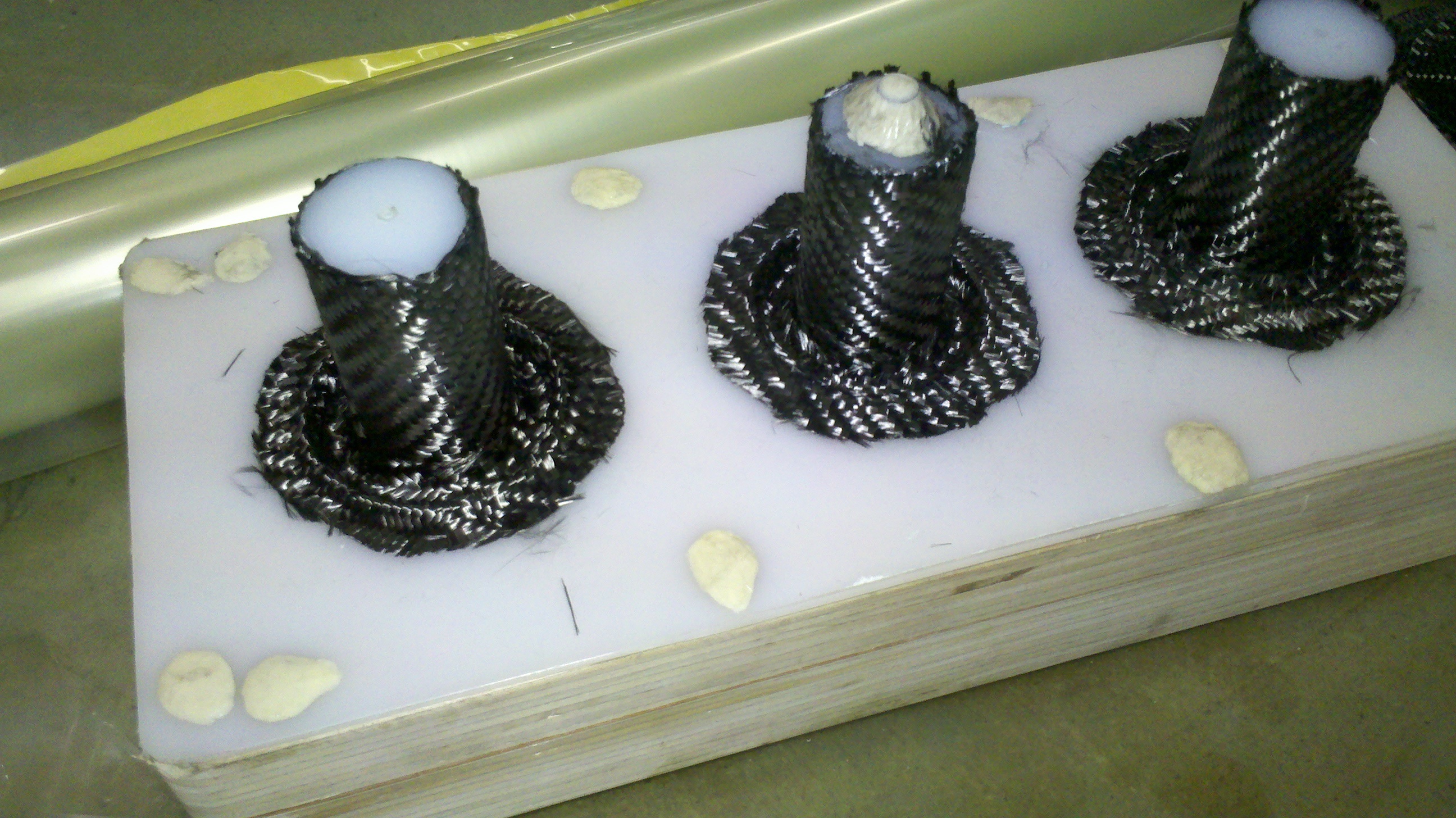
Bagging, drawing a vacuum and running through an oven while keeping that vacuum and timing it at diff temps was the harder part.
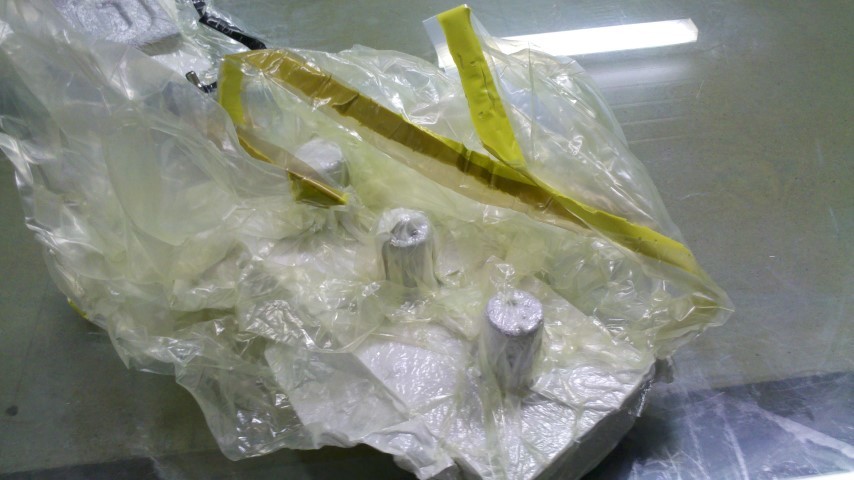
This was the second attempt at this project and it failed again. The dams on the concave curve of the trumpet end need something big pushing down on them, a “dam” in composite speak that will stop bridging of the fabric and keep it against the mould.
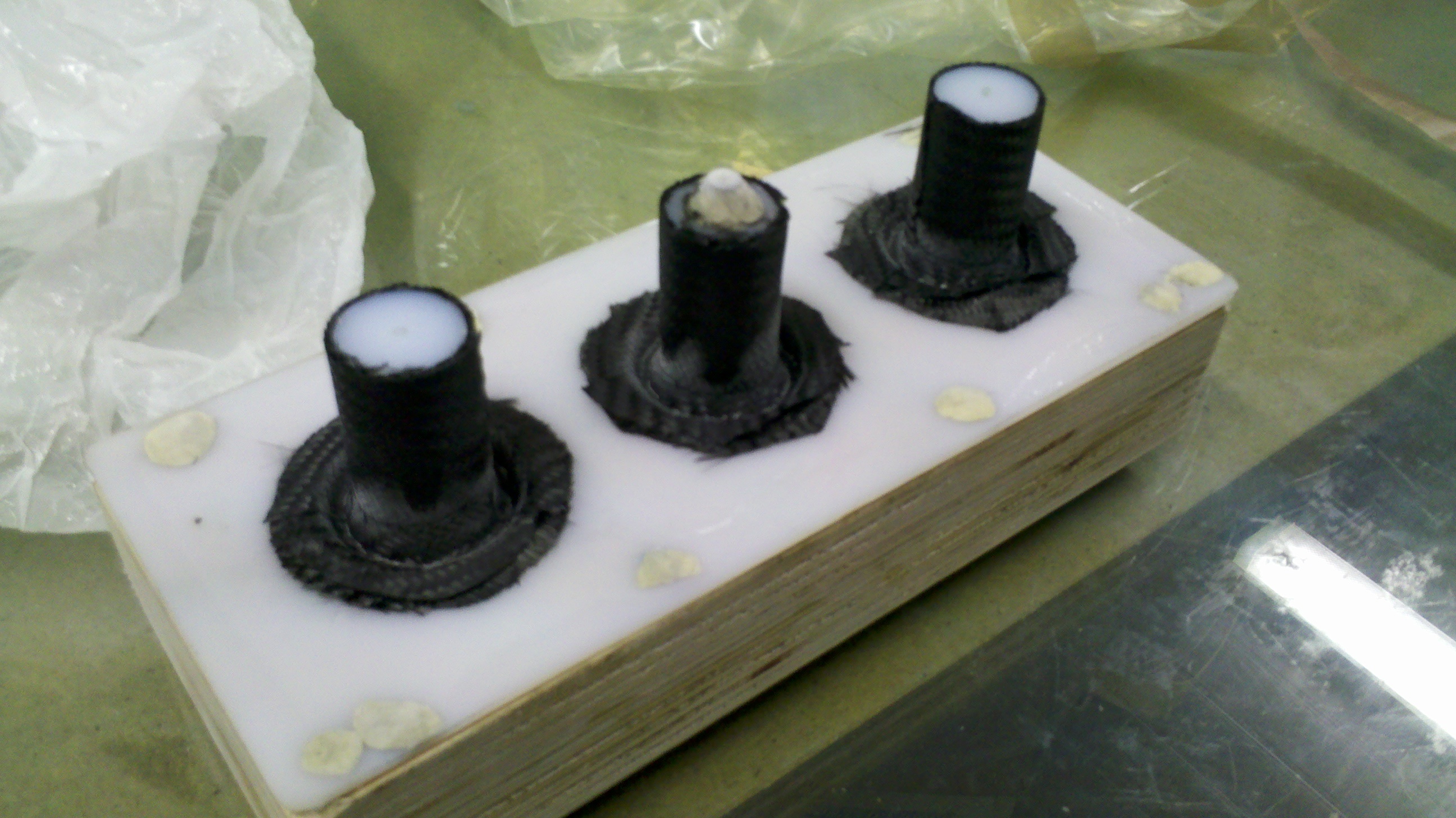
A third attempt will be done. This time with carbon fibre “sock” in three layers and done such that the outer edge of the bell does not need trimming. The mould is loaded with carbon and ready to go. Alas it has had to be shelved fro now due to other priorities. I will prob get done when the vacuum gear gets set up for another project or when the new oven at work arrives (old one died).
